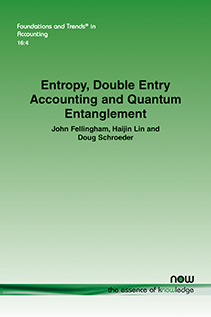Entropy, Double Entry Accounting and Quantum Entanglement
By John Fellingham, Fisher College of Business, The Ohio State University, USA, fellingham.1@osu.edu | Haijin Lin, C. T. Bauer College of Business, University of Houston, USA, haijinlin@uh.edu | Doug Schroeder, Fisher College of Business, The Ohio State University, USA, schroeder.9@osu.edu
Abstract
This monograph analyzes accounting using information theory developed by Claude Shannon and others. A three-way framing equivalence is derived (i) when states are observable; and (ii) when states are not observable and only a signal is observable where the signal reports the state with error. The equivalence establishes equality of accounting numbers, firm rate of return, and the amount of information available to the firm where Shannon’s entropy is the information metric. The major assumptions used in deriving the state observable equivalences are constant relative risk aversion preferences, arbitrage free prices, and geometric mean accounting valuation. State unobservability is modeled using the quantum axioms, and, hence, quantum probabilities; the state is unobservable in the same way quantum objects are unobservable. The state observable equivalence is seen to be a special case of the state unobservable equivalence.
Quantum probabilities allow analyzing the effects of entanglement, a phenomenon not occurring when classical probabilities are used. Entanglement is seen to be a powerful economic force, and caused by instantaneous communication of information. We speculate double entry accounting can be a mechanism for creating entanglement effects as (i) double entry accounting conveys information relevant to the expected return maximization and entropy reduction; and (ii) it does so instantaneously as the same number is simultaneously available in two places (due to double entry).
Entropy, Double Entry Accounting and Quantum Entanglement
The double entry accounting system is over five centuries old. While commerce and technology have changed in dramatic and unforeseen ways, the double entry system continues to survive and even thrive. The reasons for its durability and longevity remain something of a mystery. Entropy, Double Entry Accounting and Quantum Entanglement speculates on the reasons for double entry accounting’s apparent usefulness. The monograph is organized as follows. Section 2 establishes the three-way classical equivalence. Section 3 establishes the three-way quantum equivalence. The classical equivalence is a special case of the quantum equivalence. Section 4 defines the observability gap and runs thought experiments to show that entanglement can reduce the observability gap. The authors interpret entanglement in the quantum world using the Bell Theorem and conjecture that double entry accounting is a mechanism for entanglement in the business world. Section 5 provides a conclusion and proofs are provided in the appendix.
